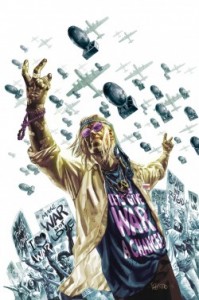 Fight Club 2 #6
Fight Club 2 #6
Dark Horse Comics
Maybe the most, uh, coherent issue of Fight Club 2 so far – Sebastian’s psychiatrist, who has been bringing Tyler Durden back for forty-five minutes a week for ten years – seemingly changes sides, revealing a key piece of Tyler’s true nature (which we knew already if we’ve read Chuck Palahniuk’s short story Expedition, but which Sebastian didn’t know until just now): that is, Tyler is inherited. He wasn’t able to fully manifest in Sebastian’s psyche until Sebastian’s father was dead, but now that Sebastian is himself a father, Tyler no longer needs him. In the past, Tyler could never kill Sebastian – it would have been suicide. But now that Sebastian has a son – a son whom Tyler has hidden away somewhere, into whose life he has already insinuated himself – Tyler can kill Sebastian and still go on living. Only by killing Sebastian’s son can Tyler truly die; and Tyler is trying to get Sebastian to kill the psychiatrist by convincing Sebastian that he (the psychiatrist) only wants Sebastian to find his son so that he (the psychiatrist) can kill him (Sebastian’s son) and thus kill Tyler.
Also, Marla is presumed dead, but really she’s in some Middle Eastern warzone with a Progeria faker who’s really Chloe from Fight Club – full of malignancy but still alive! Confusing, but that’s fine. Marla admits that she “Said no to a lot of guys before [she] said yes to Sebastian. Smarter guys. Rich ones.” So, why Sebastian? Evidently, because he was so good in bed. Except he wasn’t. Tyler was. The bad decisions we make, the ones that seem so reasonable at the time…that kind of scene, that kind of disclosure, actually reveals something shocking and profound about Marla’s character and her and Sebastian’s life together. Yet there’s just something that feels wrong with the pace of this story or something…I’m just not sure what it is. Cameron Stewart’s art is perfect for this title, so it’s not that. Again, maybe it will seem to work better when the whole series is complete and I read it straight through from beginning to end. I’ll let you know, okay?
Where to Start: Fight Club 2 #1 Time Commitment: 5 issues, not including the novel Fight Club.
Recommended if you like this: Seaguy
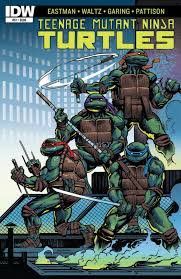 Teenage Mutant Ninja Turtles #51
Teenage Mutant Ninja Turtles #51
IDW Publishing
“The Story So Far: Shredder is dead and everything has changed. Splinter and the Turtles now lead the Foot Clan. Michelangelo, unable to accept this new development, has left his brothers.”
Picking up just a little while after the continuity-shaking events of TMNT #50, #51 almost feels like a completely different comic – and that’s a complicated statement, so let me clarify. For the most part, I’ve really enjoyed IDW’s take on the Turtles (although not as much as I’ve enjoyed the Nickelodeon cartoon, which is really just absolutely top-notch and I can’t recommend it enough). But it hasn’t always felt like the Turtles, if you know what I mean…which would surprise me, if you did, because I don’t even entirely know what I mean. There have just been some issues that didn’t seem like they quite belonged in the Turtles canon – not that they were bad but something just felt off. Don’t get me wrong, there’s also been a lot of stuff in this series that has been great! I’m not sure.
Anyway, the point of all this is that I really really liked this issue. It feels a lot like old-school Mirage TMNT, there’s some kind of authenticity that wasn’t consistently part of the series before. Who knows if it will continue, but the relationships, the action, and especially the artwork (by Ken Garing, whose depiction of the Turtles is probably now tied with Sophie Campbell’s (previously credited as Ross Campbell) for my favourite of IDW’s visual version of the Turtles.
Anyway – to the plot! Splinter and the Turtles now lead the Foot, and are trying to make it a force for good in the city. But they’ve got their work cut out for them, with the rest of NYC’s street gangs figuring that the Foot has lost not only their leader but their edge, and trying to muscle their way in for a piece of the action. There’s also pressure from within, with some of the higher-ranking Foot not taking too kindly to the Turtles’ no-more-crimes-and-no-more-killing policy. It’s a big break in the status quo, and goes right along with the introduction of the mysterious cloaked figures capable of phasing through matter who are working for – or with – one of the Italian gangs, at least for the moment.
What I know is that I’m excited about this series all over again, it feels classic but fresh – not rehashing old storylines but retaining the atmosphere and relationships and the weird sense of ninja intrigue that makes the Turtles so cool at their best.
Where to Start: Teenage Mutant Ninja Turtles Volume 1: Change is Constant Time Commitment: 50 issues.
Recommended if you like this: Teenage Mutant Ninja Turtles Ultimate Collection Volume 4
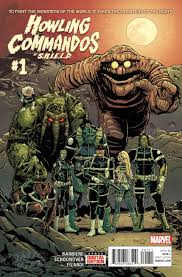 Howling Commandos of S.H.I.E.L.D. #1
Howling Commandos of S.H.I.E.L.D. #1
Marvel Comics
Now here’s a lot more Marvel books! Okay, this comic has a hell of a fun premise: Dum Dum Dugan, one-time compatriot patriot of Captain America and recently revealed to be a Life Model Duplicate, is given control of a special division of S.H.I.E.L.D. called S.T.A.K.E. (Special Threat Assessment for Known Extranormalities…which, I mean, known extranormalities? Come on, Director Hill, you can hire somebody to come up with better backronyms than that), wherein weird monsters are recruited to fight other weird monsters.
So we’ve got obscure Marvel characters like Zombie, Teen Abomination, Manphibian, Vampire By Night, Orrgo, Man-Thing, and Hit-Monkey (and I was going to put those names in ascending order of dumbness but then I couldn’t figure out which was dumber than which) boarding a tanker at sea that’s smuggling a mystical artifact that turns everybody who touches it into a weird plant ghoul kind of thing.
It’s a great and hilarious concept for a comic, but they gave writer Frank J. Barbiere a difficult task in managing such a large group of personalities and not just making them work but giving us interesting and appropriate stories. The first issue feels a little too much like a monster-of-the-week that also has to cram in a bunch of exposition. A slower start would have been better, probably, but a slower start also wouldn’t have been exciting enough an introduction to get readers onboard. So I didn’t enjoy this comic as much as I wanted to, but it’s got a ton of potential.
Where to Start: Here! Time Commitment: Now!
Reccomended if you like this: Marvel Masterworks: Sgt Fury Volume 1
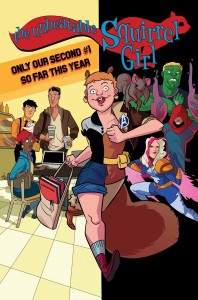 The Unbeatable Squirrel Girl #1 / Howard the Duck #1
The Unbeatable Squirrel Girl #1 / Howard the Duck #1
Marvel Comics
Now here’s what I’ve been waiting for. A couple of books that live off in the corner of the Marvel Universe, and were off at a really good pace when Marvel went and rebooted everything. So both of these books are having their second #1 issues in less than a year, which is weird. But these books are also really weird! Weird and great.
Both these books also do a really good job of being first issues without disrupting the narrative flow of the stories that came before them. In Squirrel Girl we get the titular character (real name: Doreen Green) saving some people from a burning building in the first four pages, immediately establishing her powers and personality using action and dealing with the expositiony stuff that feels more like character development than exposition – Ryan North is one of those writers (like Joss Whedon and Chuck Palahniuk and Jhonen Vasquez, for instance) with an immediately identifiable idiolect that he invests in all of his characters, and if you find it funny and charming you’re just going to like these people and want to spend your time with them. I happen to be one of those people who finds it funny and charming, and I love Squirrel Girl and her friends and want to keep spending time with them.
Page 2 of this first issue also establishes that “if you are in the market for a comic that features second-year computer science students and rhyming animal names, then friend, you have come to the right friggin’ place.”
It’s also an origin story, of sorts. We get to meet Squirrel Girl’s mom, who is just so great and nice and supportive of her daughter that you really see how Doreen got to be the great and nice and funny person that she is. We learn that Doreen was born with her powers because of something that happened during her mother’s pregnancy, but that the doctor made it very clear to her parents that “Doreen is medically and legally distinct from being a mutant, and I can never take this back.” Which is a very meta joke, and also speaks to what I think is one of the biggest problems that Marvel has at the moment that’s letting its commercial concerns affect its storytelling. More on that later.
Anyway so Hydra cyborg guy Brain Drain appears in this issue and Squirrel Girl does that thing she does of making bad guys see the error of their ways, or at least that there’s a less evil way to accomplish their goals, and now Empire State University has a brand new first-year CompSci student who’s a nearly-centenarian reformed Nazi cyborg. How cool is that?
This is one of the few books that I trust so much I’ll stick with it no matter what.
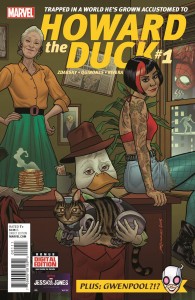 Howard the Duck, similarly, is one of Marvel’s attempts to bring back and rehabilitate weird old characters by giving them over to the control of weird awesome writers. In this case, Chip Zdarsky. And it’s working. In fact, this might be an even better first issue of Howard the Duck than Zdarsky’s first first issue of Howard the Duck, which was pretty great to begin with.
Howard the Duck, similarly, is one of Marvel’s attempts to bring back and rehabilitate weird old characters by giving them over to the control of weird awesome writers. In this case, Chip Zdarsky. And it’s working. In fact, this might be an even better first issue of Howard the Duck than Zdarsky’s first first issue of Howard the Duck, which was pretty great to begin with.
Howard’s a Private Eye now, and with his friend and assistant and shape-shifting Skrullovore Tara Tam, is advised by Dr. Strange that the recently-acquired Abundant Glove, which is like the Infinity Gauntlet only less so, may be the key to returning Howard to his home dimension. By taking the Glove to the Nexus of All Realities (which is in Florida, of course), Howard hopes to escape from this world to which he’s become accustomed – but the supervillains Titania and Wizard (who, we learn, has legally changed his name to Wizard) are already there, planning to use the Nexus (or, as Wizard calls it, the…Wizard’s Hole…) to acquire the multiverse’s greatest weaponry and take over this universe. Well, not this universe. Earth-616. You know what I mean.
Howard and Tara defeat the villains but are then confronted by Rule 63 versions of Howard and Rocket Raccoon! Dun dun dun. Tune in next month!
I didn’t know Chip Zdarsky as a writer before I knew him as an artist, but as artist on Sex Criminals so much of the atmosphere and comedy come through the visuals that I should have realized Zdarsky was just as smart and funny a storyteller as writer Matt Fraction. I didn’t realize it then, but I realize it now. In Howard the Duck, Zdarsky brings the humour and absurdity, but also the character development and genuine pathos.
But then also there is a backup story by Chris Hastings featuring the first appearance of Gwenpool! Who is Gwen Stacy if she were Deadpool, apparently. This is good stuff, you guys.
It’s hard enough to be funny, but to be funny with real depth and a great storyteller? It’s a rare gift. North and Zdarsky forever.
Where to Start: Here’s a good place. Time commitment: Just start here, I told you!
Reccomended if you like this: Unbeatable Squirrel Girl Volume 1: Squirrel Power and Howard the Duck Volume 0: What the Duck?
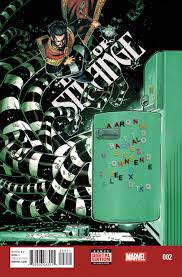 Doctor Strange #2
Doctor Strange #2
Marvel Comics
Opening exactly where Issue 1 left off, Strange leads Zelma, the young librarian who, it turns out, is infested with some delightful extradimensional parasites called Mind Maggots, on what amounts to a tour of his Sanctum Sanctorum as he seeks out the resources he needs to diagnose and cure her. Really, of course, he’s leading us on that tour – and Doctor Strange’s house is a weird place indeed, even when it’s not going borderline-berserk for as-yet-unknown-to-him reasons. This isn’t a travelogue story, though. Writer Jason Aaron has invested the house with enough character and mystery that every new room holds a new shock or smile. The fridge is haunted. There are snakes on the coffee table (don’t talk to them). The bathhouse has some, like, weird ghost physiotherapists. It reminds me a little of Neil Gaiman’s Sandman, which artist Chris Bachalo worked on briefly as well. Though this issue didn’t advance the story very much, it’s so entertaining on its own terms that I hardly noticed.
Where to Start: Doctor Strange #1 Time Investment: One!
Recommended if you like this: Doctor Strange: The Oath
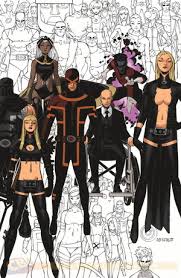 Uncanny X-Men #600 / Extraordinary X-Men #1
Uncanny X-Men #600 / Extraordinary X-Men #1
Marvel Comics
Remember some weeks ago when I was complaining that comics didn’t have high numbers anymore? As if to make me personally look dumb, here’s Uncanny X-Men #600. It’s nice to see that they actually are keeping count, despite all the relaunches and reboots and new Number Ones over the years.
The unfortunate thing is that X-Men is kind of a big mess. As writer Brian Michael Bendis writes in his farewell message at the end of the issue, “The X-Men are a sprawling comic-book universe unto themselves. A literal cast of thousands who carry with them the long-powerful shadows of cretors who have made such a profound stamp that they almost feel like part of the cast.” He’s right, and that’s a big part of the problem. Bendis is one of the best writers that comics has ever seen, but I’m afraid that X-Men has just really lost the plot. And I say that as an X-Fan from wayback. I mean, not that wayback. Like, the 90s. But still.
This issue, this landmark issue, is just boring and confusing as hell. The X-Men assemble to give Beast an intervention or, as he sees it, a trial. They think he’s gone off the rails and is becoming a danger to himself, to others, and the whole world. Most notably he yanked the original X-Men out of the past and into the present and now they’re stuck there – which doesn’t make any sense in a space/time continuum kind of way, but could have been a really interesting reverse Days of Future Past kind of storyline and then just wasn’t. Instead it’s ponderous and tiresome. It’s just like…X-Men has run out ideas, and I’m not sure whether that’s deliberate or not.
Recently, mutants have established a homeland called Utopia, where they are supposed to be safe from persecution. That was a really great idea when it was proposed the first time. It was called Genosha, and Grant Morrison blew it up. Literally. Then there was the time that Scarlet Witch went nuts and said “No More Mutants” and then suddenly there were fewer than 200 mutants left in the world. Then they got better – better enough to need a new homeland, at least. And but now the Terrigen mist that’s been released on Earth is awakening powers in all kinds of people – but killing mutants, and apparently sterilizing the ones left alive. So most of the mutants in the world are now dead or disappeared – they all went to space maybe? – and they’re an endangered species yet again. Also Iceman is now gay. This will probably remain canon for longer than the single issue where Beast came out of the closet (Grant Morrison again).
Uncanny 600 leads right into Extraordinary #1, where things don’t get any better or less boring. I don’t blame the writers for any of this. It’s a meta-problem on the corporate level. Since Marvel now makes most of its money from Hollywood adaptations of their properties, it’s in their interest to tank the ones whose rights aren’t owned by Marvel Studios. 20th Century Fox owns the film rights to the Fantastic Four and X-Men, and so Marvel seems to be deliberately ruining those titles (cancelling FF entirely and doing all this nonsense to the X-Men). And that’s why Squirrel Girl isn’t a mutant (lucky for her). Marvel has destroyed mutantkind in favour of the Inhumans – who are basically just mutants except much less interesting and not very metaphorically potent.
Even aside from corporate assassination, maybe society has just changed to the point where the symbolism that was so effective in past decades doesn’t work as well anymore. Not that we’ve “solved” the problem of discrimination against minorities, of course, but with the centrality of identity politics today, could it be that the intellectual field is now just too complicated and fractious for the X-Men and what they stand for to be of any use to anyone anymore?
See, that would actually be an X-Men story that I’d like to read. But it probably isn’t one that we’re going to be allowed to get – at least not until 2023, the earliest possible date that Marvel can get the rights to the X-Men back from Fox. Which is sad. Back in my day, man, the X-Men were cool. In the meantime, Marvel, if you’re determined to make X-men stories deliberately crappy: no more mutants – please.
Where to Start: Marvel Masterworks X-Men Volume 1 Time Investment: Like fifty years.
Reccomended if you like this: X-Men: Fatal Attractions
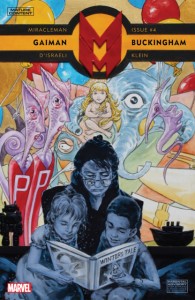 Miracleman, Book Four #4
Miracleman, Book Four #4
Marvel Comics
Finally we get a story of the actual Miracle Family – sort of. Miracleman’s sperm has been sent out to childless women who applied to carry superhuman children, and this issue tells a story of one such family; or rather, it tells a story of telling a story: the story of what happened to Winter, Miracleman’s first child, after she left Earth as a baby to discover what’s going on in the universe.
The story is told in the style of a children’s book, detailing little Winter’s travels to see the Qys. On her way she meets the Skella Merchants, who give her tea and a silver star boat; the Perlii, who think it’s weird that she doesn’t have a mate; a Warpsmith who tells her that her father was fighting Kid Miracleman, and, later, that he (her father) won; the Sauk, one of whom she marries; and so on, until she reaches the Qys.
It’s kind of the least interesting issue of Book 4 thus far, mostly because Winter is such a boring character. She’s a superpowered infant, but she hasn’t got a lot of personality besides a kind of smug and condescending awareness of her own superiority. That’s more Alan Moore’s – uh, I mean, The Original Writer’s – fault than Neil Gaiman’s, and I suspect that Gaiman is using it (as he’s doing with all the rest of the godlike Miracle Family) as a way of illustrating how kind of messed up it is when you put in charge those people who really believe that they ought to be in charge.
Where to Start: Miracleman Book 1 Time Investment: 19 issues.
Reccomended if you like this: Black Orchid
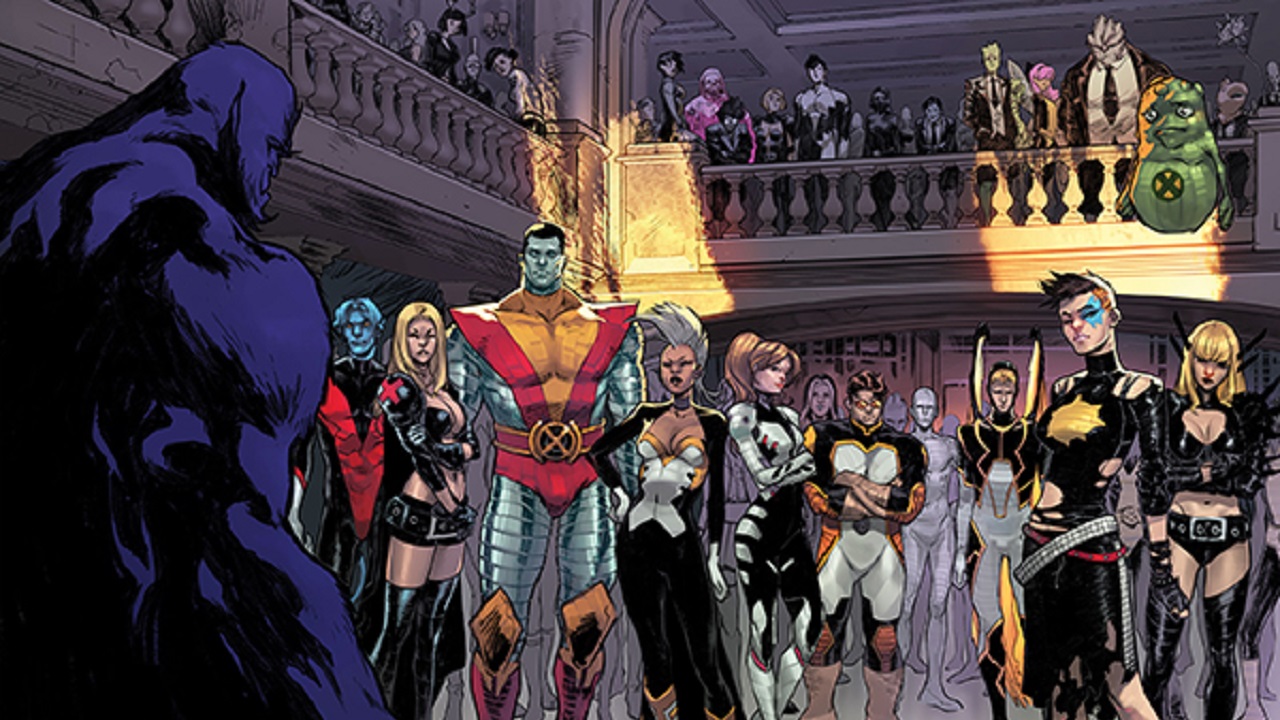
Add a Comment